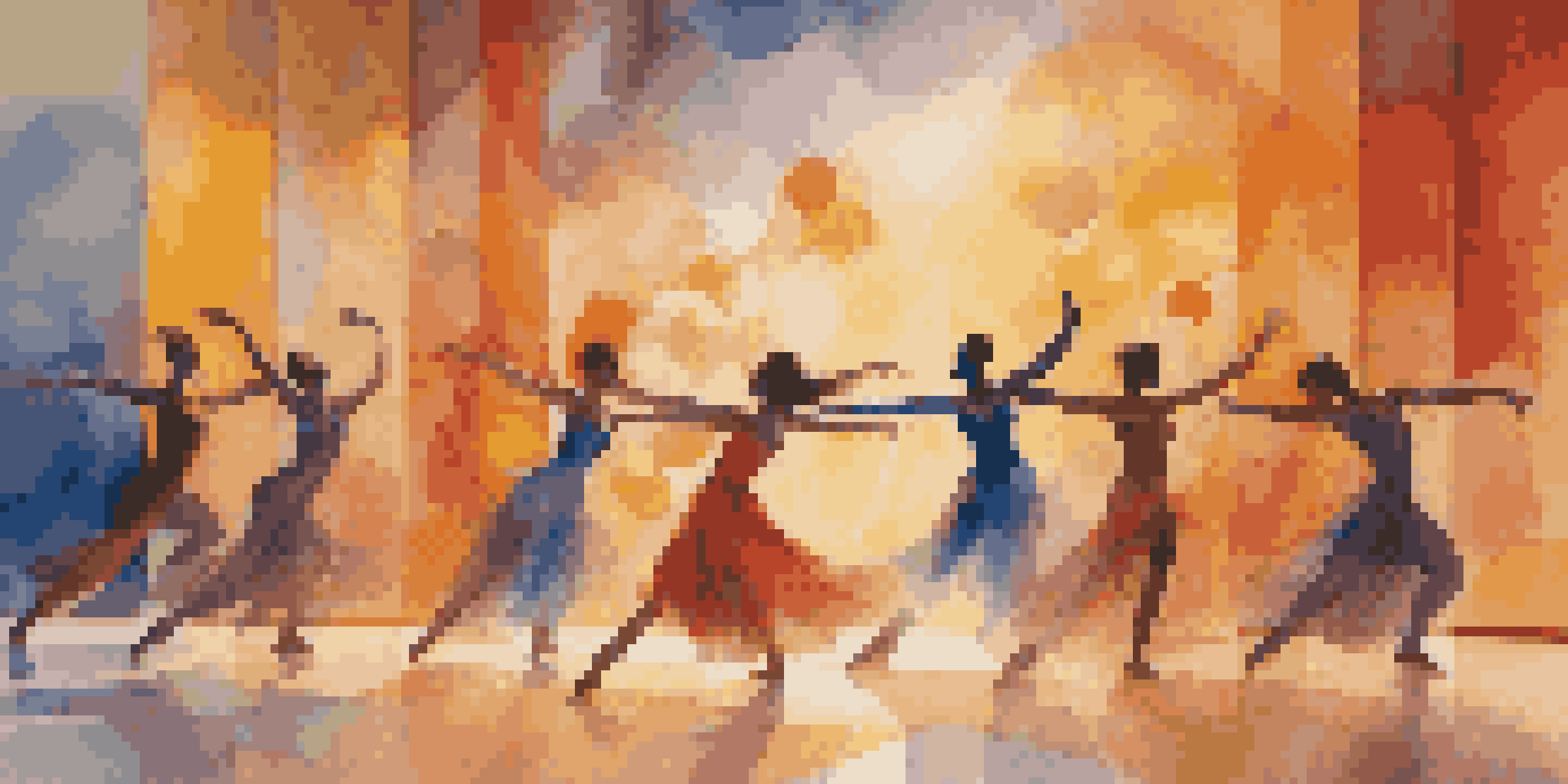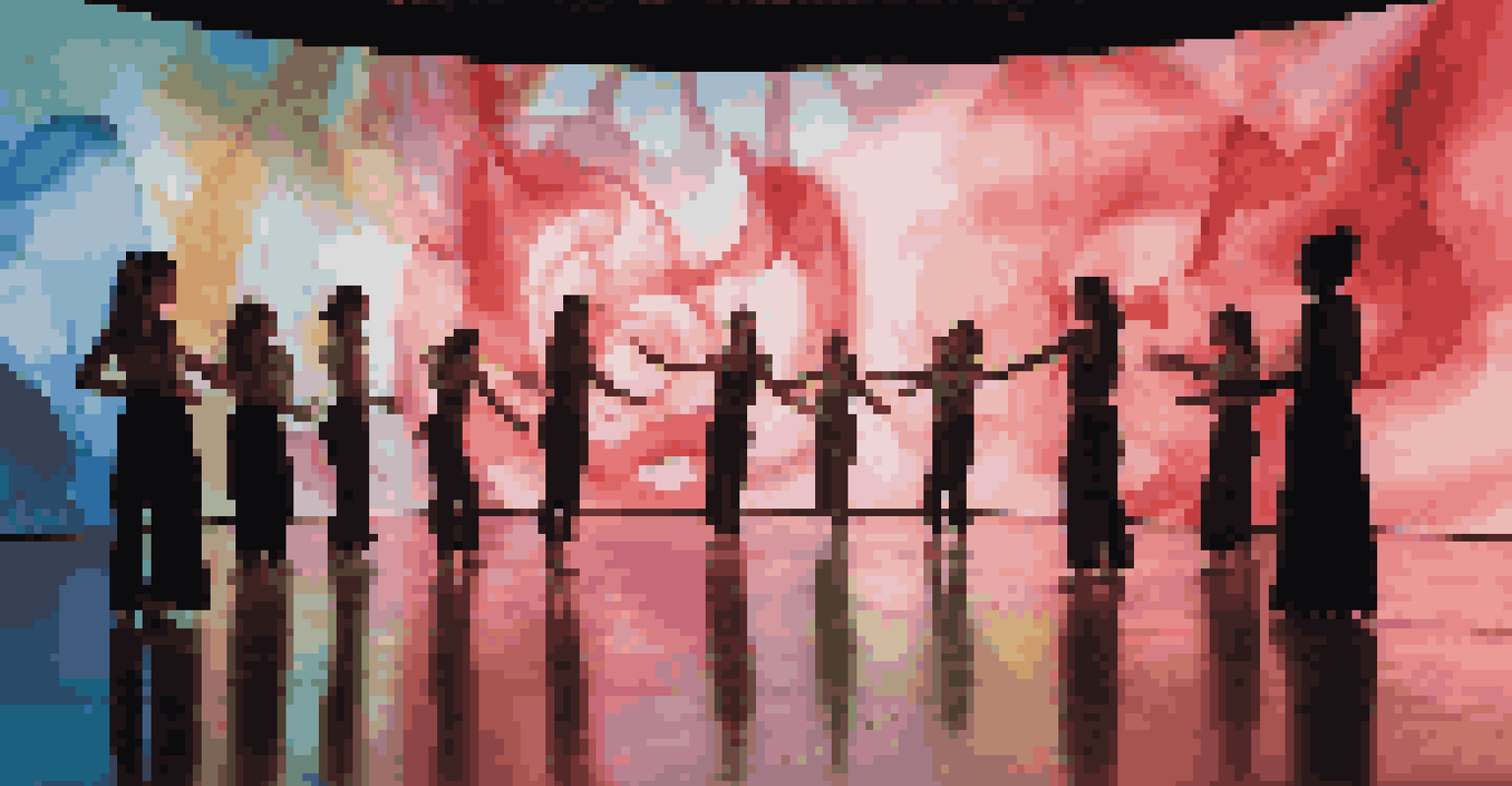Dance and Visual Arts: A Symbiotic Relationship Explored

The Essence of Movement: Dance as a Visual Art Form
Dance is often seen as a fleeting art, but it captures emotions and stories through movement. Each gesture and position conveys meaning, much like a brushstroke on canvas. When dancers perform, they translate feelings into a visual spectacle that resonates with the audience. This ephemeral nature makes dance a unique form of visual art, where the body becomes the medium of expression.
Dance is the hidden language of the soul.
Consider how a dancer’s fluid movements can evoke the same feelings as a beautifully painted landscape. Both art forms aim to communicate a narrative, whether through the rhythm of the body or the colors on canvas. This connection highlights how movement can be seen as visual poetry, allowing audiences to interpret and feel a story unfold.
Moreover, the physicality of dance often inspires visual artists to explore movement in their work. The dynamic lines created by a dancer's body can influence painters and sculptors, inviting them to capture motion in a static form. This interplay between dance and visual arts enriches both disciplines, creating a dialogue that transcends traditional boundaries.
Visual Arts Inspiring Dance: A Creative Exchange
Visual arts have a profound influence on dance, sparking creativity and innovation in choreography. For instance, a vibrant painting can inspire a choreographer to develop a dance piece that embodies the colors and emotions of the artwork. This kind of inspiration fosters collaboration between dancers and visual artists, leading to unique performances that reflect both mediums.

Take, for example, the works of artists like Wassily Kandinsky, whose abstract compositions invite interpretations through movement. Choreographers often study such pieces to create dances that resonate with the visual elements present. This synergy not only enhances the dance but also provides a fresh lens through which audiences can appreciate both forms of art.
Dance as Visual Storytelling
Dance captures emotions and narratives through movement, making it a unique visual art form that resonates deeply with audiences.
Additionally, exhibitions combining dance performances with visual art installations create immersive experiences. Audiences are drawn into a multi-sensory journey where they can watch dancers interact with the artworks, making connections between the two. This fusion encourages viewers to see dance as a living extension of visual art.
The Role of Technology in Blending Dance and Visual Arts
Technology has opened up exciting avenues for the collaboration between dance and visual arts. Digital projections, interactive installations, and augmented reality allow dancers to engage with visual elements in real-time. This innovative approach creates captivating performances that push the boundaries of both disciplines, inviting audiences to experience art in a whole new way.
Art is the most beautiful of all lies.
For instance, choreographers can now use software to visualize their movements alongside digital art, integrating both elements seamlessly. This not only enhances the storytelling aspect but also allows for a more immersive viewer experience. Audiences become part of the artwork as they watch dancers move through environments created by technology.
Moreover, virtual reality (VR) is transforming how we perceive performances, enabling viewers to step into a world where dance and visual arts coexist. This immersive technology breaks down traditional barriers, allowing for a deeper engagement with the art forms. As we embrace these advancements, the potential for creative exploration between dance and visual arts continues to grow.
Cultural Narratives: Dance and Visual Arts as Storytellers
Both dance and visual arts serve as powerful mediums for storytelling, often reflecting cultural identities and histories. Through movement and imagery, artists convey narratives that resonate with their heritage. This shared ability to narrate experiences allows for a rich exploration of themes that are both personal and universal.
For example, indigenous dance often incorporates visual elements that symbolize spiritual beliefs and cultural practices. These performances tell stories that have been passed down through generations, preserving traditions and fostering a sense of community. The integration of visual arts in such contexts enhances the storytelling, offering audiences a multi-layered understanding of the culture.
Synergy Between Arts Inspires Innovation
The collaboration between dance and visual arts sparks creativity, leading to innovative performances that blend both mediums seamlessly.
Furthermore, contemporary artists are using dance and visual arts to address social issues. By merging these forms, they create powerful statements that challenge viewers to reflect on current events. This collaboration not only amplifies their voices but also fosters a deeper connection between the audience and the themes presented.
Collaboration in Practice: Notable Dance and Visual Arts Projects
Several notable projects exemplify the successful collaboration between dance and visual arts. One such example is the work of choreographer Martha Graham, who often collaborated with visual artists like Alexander Calder to create innovative stage designs. Their partnership resulted in productions that seamlessly blended movement with striking visual elements, captivating audiences.
Another inspiring project is the collaboration between the dance company Pilobolus and visual artists who create shadow projections during performances. This unique approach transforms the dancers’ movements into intricate visual stories, allowing the audience to engage with the art in an entirely new way. Such collaborations highlight the ongoing dialogue between disciplines and the endless possibilities that arise from creative partnerships.
These examples demonstrate how collaborative efforts can lead to groundbreaking performances that challenge traditional boundaries. By bringing together diverse artistic perspectives, dance and visual arts continue to evolve, enriching the cultural landscape and inspiring future generations of artists.
The Impact of Dance on Contemporary Visual Arts
Dance's influence on contemporary visual arts is increasingly visible in various forms, from installations to performance art. Artists are exploring movement as a subject, capturing the essence of dance within their creations. This trend signifies a growing recognition of dance as a legitimate art form, deserving of exploration and appreciation within visual arts.
Consider the works of artists like Ana Mendieta, who incorporated dance into her installations, using her body to create ephemeral art. Her performances not only celebrated movement but also challenged the traditional notions of both dance and visual arts. This intersection invites viewers to reconsider how they perceive and engage with art.
Technology Enhances Artistic Expression
Advancements in technology, such as digital projections and VR, allow for immersive experiences that deepen the connection between dance and visual arts.
Furthermore, exhibitions dedicated to dance-inspired visual arts are becoming more popular, showcasing the powerful synergy between the two. These exhibitions create a dialogue that expands our understanding of both disciplines, allowing us to appreciate the beauty of movement and the artistry behind visual creations. This interconnectedness continues to shape the contemporary art scene.
Future Directions: The Evolving Relationship Between Dance and Visual Arts
As we look to the future, the relationship between dance and visual arts is poised for further evolution. With advancements in technology and a growing interest in interdisciplinary collaborations, we can expect to see even more innovative projects emerge. This evolution invites artists to experiment with new ideas, pushing the boundaries of traditional art forms.
Moreover, the increasing focus on inclusivity within the arts means more diverse voices will shape this relationship. Artists from various backgrounds are bringing their unique perspectives to the forefront, enriching the dialogue between dance and visual arts. This diversity not only enhances creativity but also fosters a more comprehensive understanding of different cultures.

Ultimately, the future of dance and visual arts holds endless possibilities. As artists continue to explore the synergies between these two expressive forms, audiences will be treated to captivating experiences that challenge their perceptions and inspire new ways of thinking. The journey of exploration between dance and visual arts is just beginning, and we can’t wait to see where it leads.